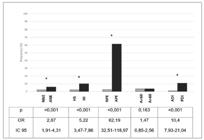ABSTRACT
Objective:
to identify a subgroup of blunt trauma patients with very low chance of sustaining pelvic fractures based on clinical criteria.
Methods:
retrospective analysis of the trauma registry data, collected in a period of 24 months. We selected adult blunt trauma patients who had a PXR on admission. The frequency of pelvic fractures was calculated for the following groups: Normal neurological examination at admission (NNE), hemodynamical stability (HS), normal pelvic examination at admission (NPE), less than 60 years old (ID<60) and absence of distracting injuries (ADI). Logistic regression analysis was carried out in order to create a probability model of negative PXR.
Results:
an abnormal PXR was identified in 101 (3.3%) out of the 3,055 patients who had undergone a PXR at admission. Out of these, 1,863 sustained a NNE, with 38 positive CXRs (2.0%) in this group. Considering only the 1,535 patients with NNE and HS, we found 28 positive PXRs (1.8%). Out of these, 1,506 have NPE, with 21 abnormal PXRs (1.4%). Of these, 1,202 were younger than 60 y, with 11 positive PXRs (0.9%). By adding all these criteria to the ADI, we found 2 abnormal PXRs in 502 (0.4%) cases. The probability model including all these variables had a 0,89 area under the ROC curve.
Conclusions:
by adding clinical criteria, it is possible to identify a group of trauma patients with very low chance of sustaining pelvic fractures. The necessity of PXR in these patients needs to be reassessed.
Keywords:
Contusions; Pelvis; Radiography; Diagnostic Imaging; Quality of Health Care

 Thumbnail
Thumbnail
 Thumbnail
Thumbnail

